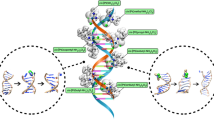Abstract.
A series of diamines with the general structure NH2(CH2) x NH2, x=2–12, was tested for their potential effects on cell proliferation of cultured rat C6 glioma cells in comparison to natural polyamines. Long chain diamines reduced cell number after 48 h in culture with a sequence of 1,12-diaminododecane (1,12-DD) >1,10-diaminodecane >1,9-diaminononane. Polyamines (putrescine, spermidine and spermine) as well as diamines up to a CH2-chain length of x=8 were found to be ineffective. The spermine analogue 1,12-DD was the most effective molecule in reducing cell number in an irreversible, dose-dependent manner (EC50=3 µM under serum-free conditions).
In further experiments we investigated the mechanisms of action of 1,12-DD. The compound had only a minor effect on cell cycle and did not affect free internal calcium concentration. Under physiological conditions 1,12-DD interacts with triplex DNA but not with duplex DNA. Ornithine decarboxylase activity as well as the concentration of internal polyamines were found to be reduced by 1,12-DD. Polyamine application, however, was not able to reverse the effect of 1,12-DD, indicating a polyamine-independent or non-competitive mechanism of action. 1,12-DD reduced cell number by induction of apoptosis as well as necrosis.
In molecular modeling studies it was found that a minimal hydrophobic intersegment of at least 4 Å was required to make a diamine an effective drug in respect to cellular growth. A hydrophobic gap of this size fits the minimum requirement expected from molecular modeling to provide space for hydrophobic interactions with parts of proteins like a CH3-group. Our results show that 1,12-DD acts as a potent drug, reducing the number of C6 glioma cells, and suggest that its spatial and hydrophobic properties are responsible for its mechanism of action.
Similar content being viewed by others

Author information
Authors and Affiliations
Additional information
Electronic Publication
Rights and permissions
About this article
Cite this article
Hochreiter, R., Weiger, T., Colombatto, S. et al. Long chain diamines inhibit growth of C6 glioma cells according to their hydrophobicity. An in vitro and molecular modeling study. Naunyn-Schmiedeberg's Arch Pharmacol 361, 235–246 (2000). https://doi.org/10.1007/s002109900188
Received:
Accepted:
Issue Date:
DOI: https://doi.org/10.1007/s002109900188



